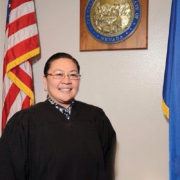
WITH the image of Las Vegas comes those of blackjack tables, slot machines, and colored poker chips with the accompanying image big cash wins and prizes.
But less thrown in the spotlight is the side of gambling where the games can get taken too far to the point of addiction. That’s where Filipina-American Family Court Judge Cheryl Nora Moss comes in.
Moss—who was elected to the District Court, Family Division in 2000 after starting her legal career serving as a law clerk in the Superior Court of the District of Columbia and as an intern in the U.S. Attorney’s Office in the capital among others — created a new specialty court that has become the first in Nevada and the second in the whole United States to deal solely with gambling.
Second only to the gambling court in Amherst, New York, the Las Vegas court is modeled after the specialty courts in Clark County, such as mental health court, veterans court, and drug court.
“I am very proud to be the first judge and probably the only judge with as much training as I had,” Moss told the Filipino Channel’s “Balitang America.”
Appointed by Chief Judge Linda Bell to direct the new specialty court, Moss started the Gambling Treatment Diversion Court in Nevada to provide an alternative option for those whose charges stem from gambling.
The Court was established after a statute was amended to allow eligible defendants to enter a treatment program instead of prison. Despite Gov. Jim Gibbons signing the bill in 2009, it took nearly a decade for the program to finally get going.
To actually get into the program, a defendant must plead guilty to a crime and that the crime came as a result or in furtherance of gambling. The program is also limited to those who haven’t been convicted of a violent crime against a person or child, or of a sexual offense.
The alternative program can last up to three years in which defendants are required to show up to Court every other Friday, but Moss said it’s their goal to have those in the program graduate in a year to 18 months, depending on how much is owed to the victim.
According to the National Council on Problem Gambling, 15 percent of Americans gamble at least once a week.
Approximately two million U.S. adults are said to meet all the criteria for pathological gambling, and four to six million are said to meet at least one of the criteria.
For Moss, the benefits of the court serve both the system and the individual in that it not only gives the offender an opportunity of rehabilitation, it also saves the system from spending more money than it should. She added that it costs $24,000 a year for just one person to be kept in prison.
“But if we rehabilitate them, address the gambling addiction so they can be in the recovery, got out and get a job, stay away from casinos—no more gambling,” said Moss.
Adding to the rehabilitation benefit, Moss emphasized that recovery also meant making sure the number of repeat offenses goes down.
“They have no concept. They just need to feel to gamble. They need to get that rush, the adrenaline, so they need to keep getting money to fuel their addiction. They don’t know how much they gamble,” Moss told Balitang America. “They don’t understand how much it all adds up and go deeper in debt. And you know when rock bottom hits when you get arrested and end up in a criminal court and get charged with a felony, not paying casino markers, bad checks, embezzlement, stealing from your boss.”
Moss added, “That’s the purpose of this court, to at least pay back the restitution to the victim. Get people the help. We want them to become a productive member of the society.” (Rae Ann Varona/AJPress with reports from Bev Llorente, Balitang America)






